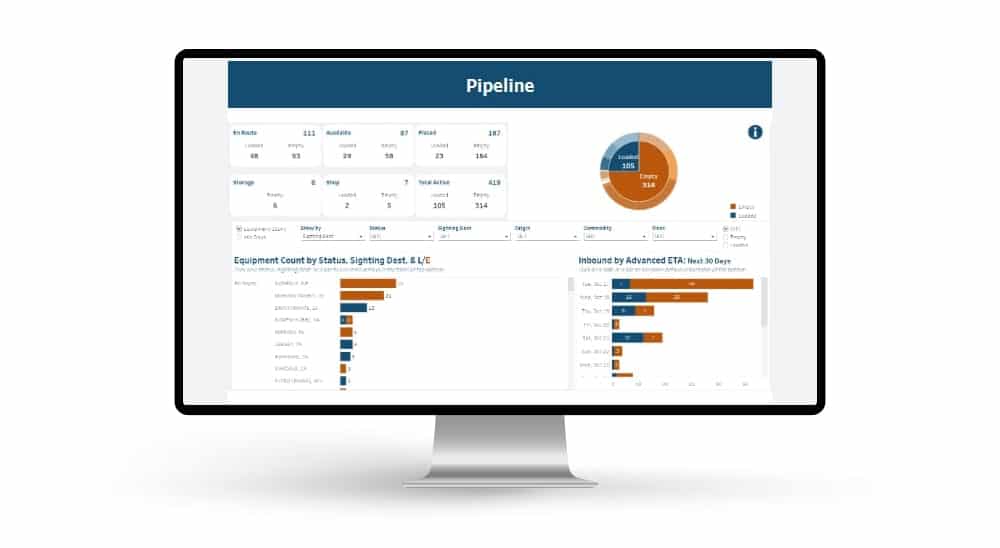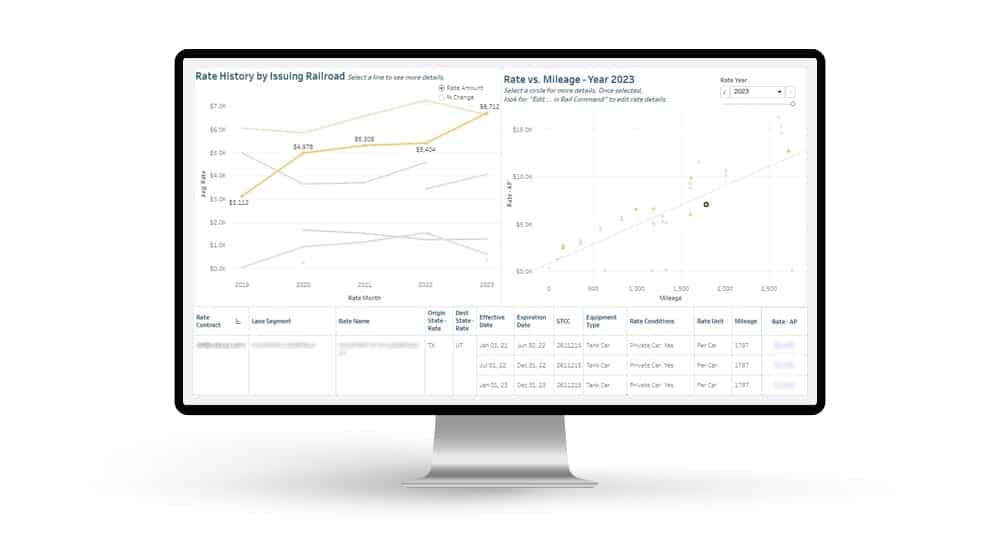Navigating through various fields of study or industry sectors often involves mastering a whole new set of vocabulary, and the field of rail freight is no exception. Just as doctors, lawyers, and computer scientists have their unique jargon, so too does this transportation sector. To truly understand the operations, processes, and intricacies of rail freight transportation, one must familiarize themselves with rail terminology.
So, let’s shine a light on some of the essential rail terminology you’d encounter in the vast lexicon of rail freight. Whether you’re a logistics student, someone considering a career in the industry, or simply a curious soul eager to learn, consider this your guide.
The Role of Rail Freight and Railroad Data
What is rail freight? And why is it important to the transportation sector?
The answer to both questions lies in rail’s capacity to haul larger loads further, at less cost than other modes, with less negative impact on the environment and infrastructure. Railroads can haul much greater loads than freight trucking, and their engines output less carbon emissions. Furthermore, by only moving on pre-established rail lines, rail shipping does not clog other types of infrastructure that are used as more than just shipping lanes – such as highways.
Types of Railroad Data and Their Purposes
To fully understand the importance of rail terminology, we first need to look at the various types of data they are utilized in. Here are the major types of railroad data and their associated roles:
Operational Data
Operational data mainly revolves around the scheduling, routing, and load management aspects of rail transportation. This data type forms the backbone of rail logistics, as it addresses the who, what, where, and when of rail freight operations. Operational data includes information such as shipment schedules, rail routes, weights of loads, and even data linked to weather conditions that may impact rail operations.
You can use operational data to efficiently manage resources, time arrivals and departures, optimize routes, and handle load-balancing challenges. Maintaining and improving your usage of operational data can help to boost your rail freight transportation’s efficiency and execution.
Real-Time Data
Tracking and visibility technologies such as Global Positioning System (GPS) and Car Location Messages (CLM) enable rail companies and shippers to gather and monitor real-time data – essential for ensuring efficient, safe, and reliable transport of goods. Real-time data can provide minute-by-minute updates on the location of assets, the speed at which railcars are traveling, or any sudden changes in the route or schedule.
For you, this visibility translates to faster, more accurate decision-making, improved ability to mitigate risks, and an overall superior level of service and customer satisfaction. For instance, our rail management solution, Rail Command® makes use of CLM messages to provide visibility on rail freight shipping, which in turn allows you to better understand where your freight logistics is, and when you can expect it to your destinations.
Regulatory Data
This type of data involves the compliance of rail operations with organizational and governmental safety, as well as environmental standards. Falling under the umbrella of regulatory data is compliance tracking and environmental impact metrics, data on safety inspections, policy adherence, and incident reports.
Gathering and analyzing regulatory data might be crucial for your organization to ensure safe operating conditions, avoid penalties and regulatory repercussions, and uphold a commitment to environmental responsibility.
Predictive Data
Predictive data is data that is used to attempt to anticipate future events or trends. Often, predictive data relies on historical data and analytics tools. Within the rail industry, predictive data can be employed for a wide range of functions – from anticipating maintenance requirements for both railcars and engines, to accurately forecasting shipping volumes and managing risks.
For instance, predictive analysis can help detect patterns suggesting that the brake of a particular railcar is nearing failure, thus allowing for preventative maintenance that could avoid costly downtime or even dangerous incidents. This capability, along with strategic demand forecasting and risk management, makes predictive data invaluable for you and your organization.
Understanding Key Rail Terminology
Understanding key rail terminology and acronyms can prove beneficial for better comprehension of both the rail transportation industry, and railroad data. Here are some of the rail terminologies that are frequently used in the rail industry:
CLM (Car Location Message)
A Car Location Message, often abbreviated to CLM, is a standard report used in the rail industry that provides information on the location of a railcar. Each CLM includes details such as the railcar’s identification number, the date and time of observation, and the location of the railcar.
As railcars move along tracks, the CLM updates, enabling railway operators and rail shippers to track the movements of their freight in real time. Solutions such as Rail Command use these messages to collect data from multiple railroads and simplify visibility in one location.
BOL (Bill of Lading)
A Bill of Lading, often referred to as BOL or B/L, is a legal document issued by a carrier to a shipper as proof of the transportation contract. It serves as a receipt acknowledging the receipt of goods and contains critical information such as the type and quantity of cargo, the origin and destination of the shipment, and any special handling requirements.
This document plays an important role in freight transportation, providing a detailed account of the items being shipped, thus enabling the seamless transfer of goods between different parties. The Bill of Lading also facilitates the protection of the rights and interests of the shipper, the carrier, and the consignee, ensuring all parties involved have clear, documented expectations.
Rule 11
In the rail freight industry, cargo often needs to be transported over the tracks of more than one rail carrier. In such cases, there are different methods of billing for and allocating charges to each railroad; one of those methods is Rule 11.
This term refers to when individual railroad companies independently negotiate and bill the shipper for their portion of the move, essentially breaking down the journey into segments. The shipper is then responsible for settling each invoice directly with the respective railroad.
Though this method involves more administrative work for the shipper, it also presents the opportunity to negotiate with each railroad, potentially decreasing overall costs. In a Through Rate move, the origin carrier can negotiate with the other carriers on your behalf, but they have little reason to pass any savings along to you, and, because you have no visibility into these charges, you won’t be aware.
Through Rate
On the other hand, a Through Rate (or Through Move) is where multiple carriers handle a single shipment through an agreed-upon revenue-sharing arrangement. Under this agreement, the rail carriers involved in the transportation process are paid by the origin carrier, who charges one overall rate to the shipper.
Although Through Rates do offer less administrative work for the shipper, and streamline the shipping process, they also make it difficult, if not impossible, to have visibility on other carrier’s rates, or have negotiating ability. What you pay for the overall move is set by the origin carrier, and they have the insight into the following carrier’s rates.
STB (Surface Transportation Board)
The Surface Transportation Board (STB) is an independent federal agency. They are responsible for regulating and overseeing the economic activities and service requirements of the U.S. interstate railroad system. Established under the Interstate Commerce Commission Termination Act (ICCTA) in 1996, the STB plays a vital role in the rail freight industry. They ensure fair competition, adjudicate disputes, and set rail freight shipping rates when required.
By monitoring and regulating business practices in the rail industry, the STB supports the growth, development, and stability of a competitive rail transportation market. It also ensures the interests of shippers, carriers, and the public are considered during decision-making. It is their responsibility to foster a balanced approach to oversight in the industry.
DWC (Damaged When Received)
The DWC, or “Damaged When Received”, is a term associated with damage claims. It’s the acknowledgment by a consignee that goods arrived in a damaged condition. The DWC note can trigger an investigation into the cause of damage, whether operational, climate-related, or a commodity-specific issue, and can influence future preventive actions.
ETA (Estimated Time of Arrival)
In the context of railway logistics, Estimated Time of Arrival (ETA) is the predicted time a railcar or their freight is expected to arrive at a specific destination. Reliable ETAs are crucial for efficient planning, maintaining logistics and supply chain flow, and avoiding unexpected delays that can impact stakeholders.
EDI (Electronic Data Interchange)
Electronic Data Interchange, commonly known as EDI, is a process that enables the electronic exchange of documents or business data from one computer system to another in a standardized format. In the context of rail freight operations, EDI serves as a bridge, a system of seamless communication between trading partners.
EDI helps streamline operations by aiding in the automatic electronic transmission and reception of essential business documents. Information such as bills of lading can be communicated directly between the systems of the shipper and the rail carrier.
GPS (Global Positioning System)
The Global Positioning System, abbreviated as GPS, is a satellite-based navigation system that delivers precise geolocation and time information. In the rail industry, GPS’ role is as a real-time asset tracker, enabling railroad companies to continuously monitor the location, direction, and speed of their railcars.
By integrating GPS systems with digital maps and real-time data analytics, you can achieve superior control over your fleets and assets, improve safety mechanisms, and offer more reliable and timely service to your customers.
Additional Rail Terminology:
RFID (Radio Frequency Identification)
RFID uses radio waves to read and capture data stored on a chip attached to an object. In rail logistics, RFID tags are often used on freight cars, allowing operators to automatically identify and track their assets.
AEI (Automatic Equipment Identification)
AEI is a system used by railroads to identify rolling stock and equipment. This can be crucial for monitoring and directing assets, as well as maintaining optimal logistical efficiency across complex rail networks.
IoT (Internet of Things)
IoT is the network of physical devices that are connected to the internet. These devices, including vehicles, machines, and appliances, can communicate or exchange data. The introduction of IoT in the rail industry allows for a high degree of automation and control. It also makes possible new developments, such as real-time cargo tracking, predictive maintenance, energy management, and much more.
Why Rail Terminology Terms Matter
Just like learning the basic vocabulary of a foreign language is essential for understanding complex grammatical structures or expressions, decoding common terms in rail freight is pivotal for comprehending the broader aspects of the industry. Ultimately, the freight terms we’ve discussed don’t exist in isolation. Each term interacts and layers upon the others to create more intricate systems and practices.
Bridging Knowledge Gaps
A clear grasp of these terms can help you understand rail freight industry conversations, presentations, or documentation. Each piece of rail terminology is a building block that is made of rules, practices, or phenomena from the industry. By mastering these terms, you’re effectively building a strong foundation for understanding the complexities of the sector. Whether you’re studying transportation logistics or planning a career in the industry, it’s important to expand your understanding.
Optimizing Efficiency
Beyond that, these freight terms reflect a focus on efficiency, technological integration, and customer service. For instance, terms like CLM show how technology can be used to enhance efficiency and service quality. And Rule 11 is an example of administrative optimization and industry cooperation.
Elevating Industry Standards
Furthermore, terms such as DWC highlight that the rail freight industry is more than a mere transactional business. It is an industry that respects quality and service. Similarly, the concept of the STB underlines the importance of ethical practices and fair competition. This benefits everyone involved in the industry – whether rail freight companies, customers, or the economy as a whole.
So, why does knowing these terms matter?
It fosters a greater awareness of not only what the rail freight industry does, but also how it operates. Understanding promotes transparency, supports economies, safeguards customers, and continually evolves to meet transport and logistics needs. Comprehension of rail terminology means appreciating the rail freight industry’s significance and role in a wider context. This is undoubtedly crucial for any student or future professional in this field.




 Automated exception reporting of the railcar tracking data makes it easy to identify and troubleshoot jeopardized shipments, thereby enabling you to provide better service to your stakeholders.
Automated exception reporting of the railcar tracking data makes it easy to identify and troubleshoot jeopardized shipments, thereby enabling you to provide better service to your stakeholders. Receive notification of pending rate expirations. Tariff changes and fuel surcharges can be automatically updated.
Receive notification of pending rate expirations. Tariff changes and fuel surcharges can be automatically updated.